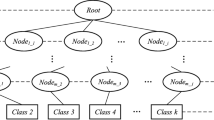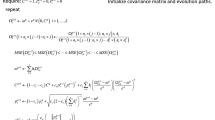Abstract
The extended belief rule-based system has been used in the field of decision making in recent years for its advantage of expressing various kinds of information under uncertainty, where the extended belief rule base (EBRB) is used to store various types of uncertain knowledge in the form of belief structures. However, as data such as expert knowledge and experimental data is used to directly generate the EBRB, there could be noisy and redundant rules that not only increase the computation cost but also reduce the accuracy. To this end, a novel framework for EBR reduction and training with the greedy strategy and parameter learning is proposed in this paper. Firstly, a greedy-based EBRB reduction method is proposed, where noisy and redundant rules are be searched and removed. Then, the EBRB training method using parameter learning is introduced, where the parameters of the EBRB are trained to increase its accuracy. Next, the framework for EBRB reduction and training is introduced, and the procedure of the proposed method is detailed. Finally, two case studies are conducted to demonstrate the effectiveness and efficiency of the proposed method, and the results show that the proposed method could reduce the size of the EBRB while increasing its accuracy.





Similar content being viewed by others
References
Abellán J, Baker RM, Coolen FP, Crossman RJ, Masegosa AR (2014) Classification with decision trees from a nonparametric predictive inference perspective. Comput Stat Data Anal 71:789–802
Bi W, Gao F, Zhang A, Yang M (2020) Dependence assessment in human reliability analysis based on the interval evidential reasoning algorithm under interval uncertainty. IEEE Access 8:222187–222198. https://doi.org/10.1109/access.2020.3043848
Calzada A, Liu J, Nugent C, Wang H, Martinez L (2014a) Using the spatial rimer+ approach to estimate negative self-rated health and its causes across northern ireland. In: International conference on ubiquitous computing and ambient intelligence. Springer, pp 312–319
Calzada A, Liu J, Nugent CD, Wang H, Martinez L (2014b) Sensor-based activity recognition using extended belief rule-based inference methodology. In: 2014 36th annual international conference of the IEEE engineering in medicine and biology society. IEEE, pp 2694–2697
Calzada A, Liu J, Wang H, Kashyap A (2014c) A new dynamic rule activation method for extended belief rule-based systems. IEEE Trans Knowl Data Eng 27(4):880–894
Chang L, Sun J, Jiang J, Li M (2015) Parameter learning for the belief rule base system in the residual life probability prediction of metalized film capacitor. Knowl-Based Syst 73:69–80. https://doi.org/10.1016/j.knosys.2014.09.006
Chang L, Zhou Z, You Y, Yang L, Zhou Z (2016) Belief rule based expert system for classification problems with new rule activation and weight calculation procedures. Inform Sci 336:75–91
Chang L, Fu C, Wu Z, Liu W, Yang S (2020) Data-driven analysis of radiologists’ behavior for diagnosing thyroid nodules. IEEE J Biomed Health Inform 24(11):3111–3123. https://doi.org/10.1109/JBHI.2020.2969322
Chang PC, Liu CH (2008) A tsk type fuzzy rule based system for stock price prediction. Expert Syst Appl 34(1):135–144
Chen Y, He F, Li H, Zhang D, Wu Y (2020) A full migration bbo algorithm with enhanced population quality bounds for multimodal biomedical image registration. Appl Soft Comput 93:106335
Derrac J, Chiclana F, García S, Herrera F (2016) Evolutionary fuzzy k-nearest neighbors algorithm using interval-valued fuzzy sets. Inform Sci 329:144–163
Dua D, Graff C (2017) UCI machine learning repository. http://archive.ics.uci.edu/ml
Duţu LC, Mauris G, Bolon P (2017) A fast and accurate rule-base generation method for mamdani fuzzy systems. IEEE Trans Fuzzy Syst 26(2):715–733
Farhan M, Omar Z, Mebarek-Oudina F, Raza J, Shah Z, Choudhari R, Makinde O (2020) Implementation of the one-step one-hybrid block method on the nonlinear equation of a circular sector oscillator. Comput Math Model 31 (1):116–132
Fu YG, Zhuang JH, Chen YP, Guo LK, Wang YM (2020) A framework for optimizing extended belief rule base systems with improved ball trees. Knowl-Based Syst:210. https://doi.org/10.1016/j.knosys.2020.106484
Gao F, Zhang A, Bi W, Ma J (2021) A greedy belief rule base generation and learning method for classification problem. Appl Soft Comput 98:106856. https://doi.org/10.1016/j.asoc.2020.106856
He W, Hu GY, Zhou ZJ, Qiao PL, Han XX, Qu YY, Wei H, Shi C (2018) A new hierarchical belief-rule-based method for reliability evaluation of wireless sensor network. Microelectron Reliab 87:33–51
Jiao L, Pan Q, Denœux T, Liang Y, Feng X (2015) Belief rule-based classification system: Extension of frbcs in belief functions framework. Inf Sci 309:26–49
Li G, Zhou Z, Hu C, Chang L, Zhou Z, Zhao F (2017) A new safety assessment model for complex system based on the conditional generalized minimum variance and the belief rule base. Safety Sci 93:108–120
Li H, He F, Chen Y (2020) Learning dynamic simultaneous clustering and classification via automatic differential evolution and firework algorithm. Appl Soft Comput 96:106593
Ligeza A (2006) Logical foundations for rule-based systems, vol 11. Springer, New York
Lin YQ, Fu YG, Su Q, Wang YM, Gong XT (2017) A rule activation method for extended belief rule base with vp-tree and mvp-tree. J Intell Fuzzy Syst 33(6):3695–3705. https://doi.org/10.3233/jifs-17521
Liu J, Martinez L, Calzada A, Wang H (2013) A novel belief rule base representation, generation and its inference methodology. Knowl-based Syst 53:129–141
Pan Y, He F, Yu H (2019) A novel enhanced collaborative autoencoder with knowledge distillation for top-n recommender systems. Neurocomputing 332:137–148
Pan Y, He F, Yu H (2020a) A correlative denoising autoencoder to model social influence for top-n recommender system. Front Comput Sci 14(3):1–13
Pan Y, He F, Yu H, Li H (2020b) Learning adaptive trust strength with user roles of truster and trustee for trust-aware recommender systems. Appl Intell 50(2):314–327
Sanchez MA, Castillo O, Castro JR, Melin P (2014) Fuzzy granular gravitational clustering algorithm for multivariate data. Inform Sci 279:498–511
Shao YH, Chen WJ, Wang Z, Li CN, Deng NY (2015) Weighted linear loss twin support vector machine for large-scale classification. Knowl-Based Syst 73:276–288
Siler W, Buckley JJ (2005) Fuzzy expert systems and fuzzy reasoning. John Wiley & Sons, New York
Sun R (1995) Robust reasoning: integrating rule-based and similarity-based reasoning. Artif Intell 75(2):241–295
Wang YM, Yang JB, Xu DL, Chin KS (2009) Consumer preference prediction by using a hybrid evidential reasoning and belief rule-based methodology. Expert Syst Appl 36(4):8421–8430
Wang YM, Yang LH, Fu YG, Chang LL, Chin KS (2016) Dynamic rule adjustment approach for optimizing belief rule-base expert system. Knowl-Based Syst 96:40–60. https://doi.org/10.1016/j.knosys.2016.01.003
Wang YM, Ye FF, Yang LH (2020) Extended belief rule based system with joint learning for environmental governance cost prediction. Ecol Indic 111:106070
Wu J, Pan S, Zhu X, Cai Z, Zhang P, Zhang C (2015) Self-adaptive attribute weighting for naive bayes classification. Expert Syst Appl 42 (3):1487–1502
Xu DL, Liu J, Yang JB, Liu GP, Wang J, Jenkinson I, Ren J (2007) Inference and learning methodology of belief-rule-based expert system for pipeline leak detection. Expert Syst Appl 32(1):103–113
Yang JB, Liu J, Wang J, Sii HS, Wang HW (2006) Belief rule-base inference methodology using the evidential reasoning approach-rimer. IEEE Trans Syst Man Cybern-Part A Syst Hum 36(2):266–285
Yang JB, Liu J, Xu DL, Wang J, Wang H (2007) Optimization models for training belief-rule-based systems. IEEE Trans Syst Man Cybern-Part A Syst Hum 37(4):569–585
Yang LH, Wang YM, Lan YX, Chen L, Fu YG (2017) A data envelopment analysis (dea)-based method for rule reduction in extended belief-rule-based systems. Knowl-Based Syst 123:174–187
Yang LH, Liu J, Wang YM, Martínez L (2018a) Extended belief-rule-based system with new activation rule determination and weight calculation for classification problems. Appl Soft Comput 72:261–272
Yang LH, Liu J, Wang YM, Martinez L (2018b) A micro-extended belief rule-based system for big data multiclass classification problems. IEEE Trans Syst Man Cybern Syst:1–21. https://doi.org/10.1109/tsmc.2018.2872843
Yang LH, Wang YM, Fu YG (2018c) A consistency analysis-based rule activation method for extended belief-rule-based systems. Inform Sci 445:50–65
Yang Y, Fu C, Chen YW, Xu DL, Yang SL (2016) A belief rule based expert system for predicting consumer preference in new product development. Knowl-Based Syst 94:105–113
Ye FF, Yang LH, Wang YM, Chen L (2020) An environmental pollution management method based on extended belief rule base and data envelopment analysis under interval uncertainty. Comput Ind Eng:106454
Yong JS, He FZ, Li HR, Zhou WQ (2019) A novel bat algorithm based on cross boundary learning and uniform explosion strategy. Appl Math-A J Chin Univ 34(4):480–502
You Y, Sun J, Yw Chen, Niu C, Jiang J (2021) Ensemble belief rule-based model for complex system classification and prediction. Expert Syst Appl:164. https://doi.org/10.1016/j.eswa.2020.113952
Zadeh LA, Klir GJ, Yuan B (1996) Fuzzy sets, fuzzy logic, and fuzzy systems: selected papers, vol 6. World Scientific
Zhang A, Gao F, Yang M, Bi W (2020a) Belief rule-based dependence assessment method under interval uncertainty. Qual Reliab Eng Int 36 (7):2459–2477
Zhang A, Gao F, Yang M, Bi W (2020b) A new rule reduction and training method for extended belief rule base based on dbscan algorithm. Int J Approx Reason 119:20–39
Zhang S, He F (2020) Drcdn: learning deep residual convolutional dehazing networks. Vis Comput 36(9):1797–1808
Zhou ZG, Liu F, Li LL, Jiao LC, Zhou ZJ, Yang JB, Wang ZL (2015) A cooperative belief rule based decision support system for lymph node metastasis diagnosis in gastric cancer. Knowl-Based Syst 85:62–70
Zhou ZJ, Hu GY, Hu CH, Wen CL, Chang LL (2019) A survey of belief rule-base expert system. IEEE Trans Syst Man Cybern Syst:1–15. https://doi.org/10.1109/tsmc.2019.2944893
Zhu HZ, Xiao MQ, Yang LH, Tang XL, Liang YJ, Li JF (2020) A minimum centre distance rule activation method for extended belief rule-based classification systems. Appl Soft Comput:91. https://doi.org/10.1016/j.asoc.2020.106214
Acknowledgements
Wenhao Bi and Fei Gao contributed equally to this work. This work is partially supported by the National Natural Science Foundation of China (No. 61903305, 62073267), the Aeronautical Science Foundation of China (No. 201905053001), the Key Laboratory Open Foundation of Data Link Technology (No. CLDL-20182113) and the Research Funds of Interdisciplinary Subject, NWPU.
Author information
Authors and Affiliations
Corresponding author
Ethics declarations
Conflict of Interests
The authors declare that they have no conflict of interest.
Additional information
Publisher’s note
Springer Nature remains neutral with regard to jurisdictional claims in published maps and institutional affiliations.
Rights and permissions
About this article
Cite this article
Bi, W., Gao, F., Zhang, A. et al. A framework for extended belief rule base reduction and training with the greedy strategy and parameter learning. Multimed Tools Appl 81, 11127–11143 (2022). https://doi.org/10.1007/s11042-022-12232-4
Received:
Revised:
Accepted:
Published:
Issue Date:
DOI: https://doi.org/10.1007/s11042-022-12232-4




